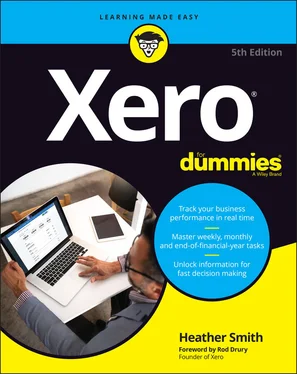Heather Smith - Xero For Dummies
Здесь есть возможность читать онлайн «Heather Smith - Xero For Dummies» — ознакомительный отрывок электронной книги совершенно бесплатно, а после прочтения отрывка купить полную версию. В некоторых случаях можно слушать аудио, скачать через торрент в формате fb2 и присутствует краткое содержание. Жанр: unrecognised, на английском языке. Описание произведения, (предисловие) а так же отзывы посетителей доступны на портале библиотеки ЛибКат.
- Название:Xero For Dummies
- Автор:
- Жанр:
- Год:неизвестен
- ISBN:нет данных
- Рейтинг книги:5 / 5. Голосов: 1
-
Избранное:Добавить в избранное
- Отзывы:
-
Ваша оценка:
- 100
- 1
- 2
- 3
- 4
- 5
Xero For Dummies: краткое содержание, описание и аннотация
Предлагаем к чтению аннотацию, описание, краткое содержание или предисловие (зависит от того, что написал сам автор книги «Xero For Dummies»). Если вы не нашли необходимую информацию о книге — напишите в комментариях, мы постараемся отыскать её.
Xero For Dummies,
Xero For Dummies
Xero For Dummies
Xero For Dummies — читать онлайн ознакомительный отрывок
Ниже представлен текст книги, разбитый по страницам. Система сохранения места последней прочитанной страницы, позволяет с удобством читать онлайн бесплатно книгу «Xero For Dummies», без необходимости каждый раз заново искать на чём Вы остановились. Поставьте закладку, и сможете в любой момент перейти на страницу, на которой закончили чтение.
Интервал:
Закладка:
Revenue
Revenue covers the following:
Revenue: Income other than sales.
Sales: Monies earned from business operations.
Other Income: Income not related to the operations of the income — for example, bank interest.
See the section ‘ Developing your own chart of accounts’, later in this chapter, for more on how different income streams can be reflected in revenue accounts within your Xero Chart of Accounts.
Expenses
Expenses covers the following:
Direct costs: Costs incurred in providing goods or services, inclusive of freight — for example, purchase of stock.
Expenses: Costs associated with running the business — for example, telephone charges.
Depreciation: The allocation of the value of capital assets to expenses, over the life of the assets — for example, depreciation on cars owned by the business.
Overheads: Fixed costs associated with running the business — for example, rent.
See the following section for more on how direct costs relating to specific income streams can be reflected in expense accounts within your Chart of Accounts in Xero.
Creating a chart of accounts that works for you
By taking the time to define what you want to know, you can easily generate useful information. Account types, excluding bank, credit card and online payment methods, can be altered at any time. So if you have been working with a file and realise you should make some changes, you can!
This section covers some points you can take into consideration when developing a suitable chart of accounts for your business.
Measure what matters
Think about the kind of information you need to help you understand how the business is performing and so improve your decision-making process. Can you easily identify specific income streams and the direct costs of products or services you provide relating to these separate income streams? This information allows you to identify gross profit per product or service on the fly. Understanding what area of your business is more profitable (and perhaps what area isn’t bringing in the cash) makes it easier to decide where energies and such costs as advertising budgets should be focused.
Keep it simple
The primary purpose of management reports is to help managers and business owners manage the business. Use language and terminology you understand. Override technical accounting speak and replace it with lingo that helps internal staff quickly understand and digest information. If you don’t like the term accounts receivable , for example, change it to dudes who owe us money . I promise the accounting secret police won’t come knocking at your door.
 If business reports are required for outside bodies, you can extract the reports from Xero and easily reword any of the more individual terms you’ve used to suit the required accounting lingo. You, and any of your internal staff, being able to quickly view reports and understand what they mean on a day-to-day basis is more important for your business success.
If business reports are required for outside bodies, you can extract the reports from Xero and easily reword any of the more individual terms you’ve used to suit the required accounting lingo. You, and any of your internal staff, being able to quickly view reports and understand what they mean on a day-to-day basis is more important for your business success.
Less is more
If, somewhere during the process, account lines have been generated that you are unlikely to use in the next couple of years, remove them. Adding new accounts is quick and easy — so, for example, don’t hang on to the Building Premises account line in the hope that one day you may own your building. Live for today and develop a streamlined chart of accounts that suits your business now. Ask yourself whether the way you’ve split income or expense streams is really useful. Will this help you make efficient and effective decisions in your business?
Developing your own chart of accounts
When it comes to developing a chart of accounts, I like to start with a blank canvas, work out the essentials, and allow the chart to organically grow with the business. Adding new accounts as you’re developing the business is easy — so don’t feel compelled to do it all now!
 Speak with your accountant and ask if she has a preferred chart of accounts. I encourage all my clients to speak with their own tax accountant before developing a customised chart of accounts with them.
Speak with your accountant and ask if she has a preferred chart of accounts. I encourage all my clients to speak with their own tax accountant before developing a customised chart of accounts with them.
In this section, I share a few simple methods I use when I work with customers on developing a useful chart of accounts. Note: If your business is relatively straightforward, the insight you need about different income streams and the direct costs associated with these may be generated by simply using Xero’s Tracking features. (See Chapter 12for more on Tracking in Xero.)
Looking at income and direct costs
Say I had a customer who needed to define a suitable chart of accounts for her catering business. I ask to look at her business card and work out the business involves the following services (in order of income generated):
Full-service caterer
Dinnerware and linens
Chef and wait staff
DJ
Of course, if she didn’t have a business card, I could ask to look at her website or other advertising material, but typically the back of a business card sums up the business — and, if it doesn’t, the conversation probably becomes about designing business cards to promote what the business does! Back on track, in this example the caterer clearly has four main streams of sales income, each with associated direct costs. These four income streams, and the direct costs associated with each stream, need to be reflected in the account types created within Xero (and so also reflected on Xero’s Chart of Accounts).
If, for example, the caterer wanted to understand the gross profit generated by offering the services of a DJ, in her chart of accounts she would allocate an account showing DJ sale income to account type Sale, and an account showing DJ direct cost to account type Direct Cost. To identify the gross profit, she can then deduct the direct cost of employing the DJ from the sales income generated through hiring the DJ.
Setting up a meaningful chart of accounts and ensuring data is allocated correctly means useful reports can be produced and analysed. Take the time to understand what your business does, and how allocating account types can affect your reports and enhance business decisions.
Understanding other expenses
Along with direct costs (refer to preceding section), three other expense account types are possible: Expense, Depreciation and Overhead. These represent the overall operating expenses for the business, and I like to break them up over four groups:
Promotion: This relates to any advertising, marketing or promotional spend incurred by the business and is allocated to account type Expense. A catering business, for example, may include Facebook advertising and website design here.
People: This relates to staff expenditure, including wages, amenities and training advertising. Expenditure for full-time staff could be allocated to Overhead, while expenditure on casual staff is allocated to account type Expense. Continuing to use the catering business example, people expenses for this type of business may include wages, workers’ insurance and kitchen amenities.
Place: This relates to all expenses associated with the location the business occupies and is allocated to account type Overhead. A catering business may include rent, electricity and rates here.
Читать дальшеИнтервал:
Закладка:
Похожие книги на «Xero For Dummies»
Представляем Вашему вниманию похожие книги на «Xero For Dummies» списком для выбора. Мы отобрали схожую по названию и смыслу литературу в надежде предоставить читателям больше вариантов отыскать новые, интересные, ещё непрочитанные произведения.
Обсуждение, отзывы о книге «Xero For Dummies» и просто собственные мнения читателей. Оставьте ваши комментарии, напишите, что Вы думаете о произведении, его смысле или главных героях. Укажите что конкретно понравилось, а что нет, и почему Вы так считаете.












